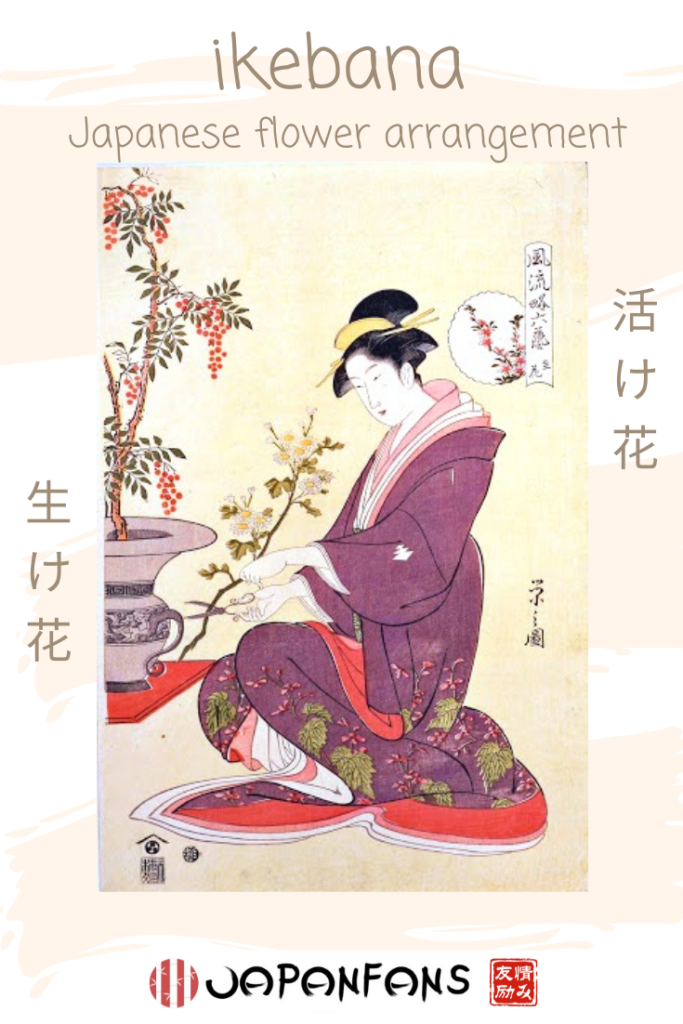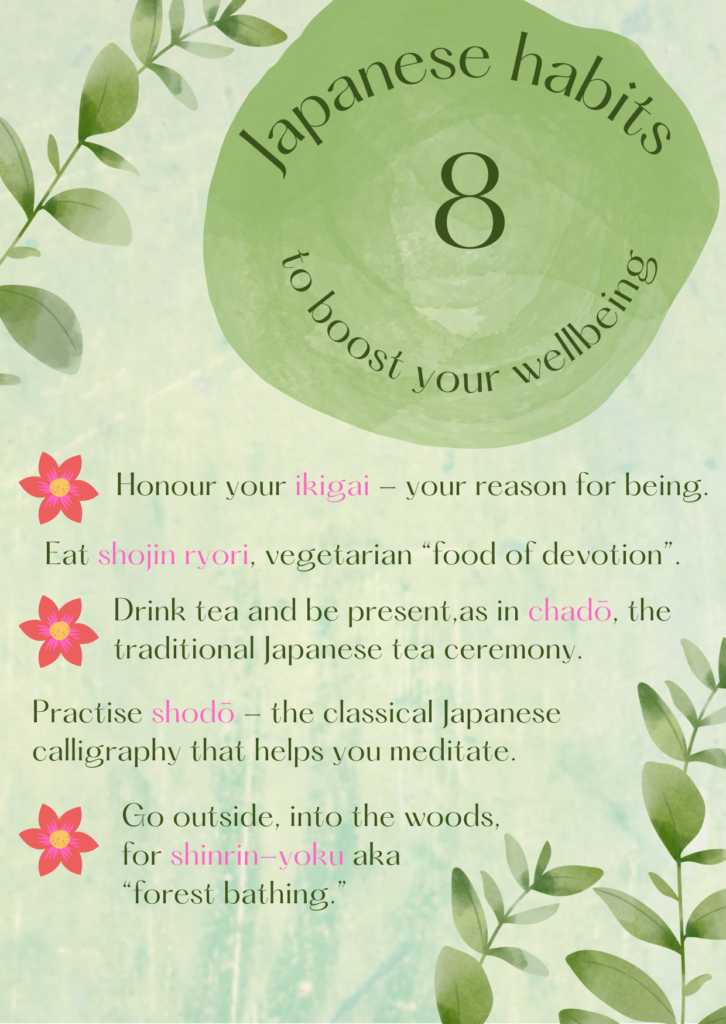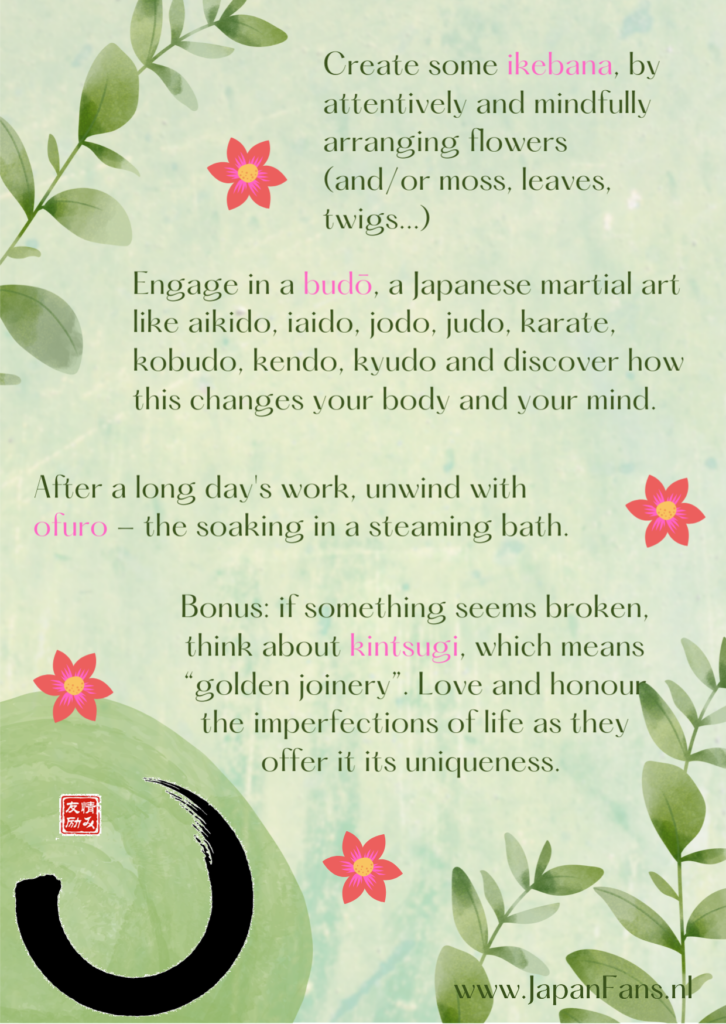One of our “Eight Japanese habits to boost your wellbeing” is create some Ikebana. Some what?! Don’t worry, in this short blogpost, Japan Fan Obanijesu Samuel from Nigeria explains the practice of Ikebana.
WHAT IS IKEBANA?
Ikebana (生け花, 活け花, “arranging flowers” or “making flowers alive”) is a traditional Japanese flower arrangement technique. It aims to bring out the intrinsic features of flowers and other elements to express emotion, as opposed to the western style of simply arranging flowers in a vase. To get the stems and flowers exactly where you want them, you’ll need to know how to attach and place them in a variety of ways. These are the skills that individuals learn in ikebana classes.
The aim to establish harmony between flower and vase, as well as to choose flowers that blend in well with its environment, guides the selection of flowers to arrange.
A brief history of Ikebana
The name is derived from the Japanese terms ike and bana, which indicate “alive or arrange”, and “flower,” respectively. This ancient Japanese ritual extends back to the Heian period when the ancient Japanese made floral tributes at the temples. Ikebana is also known as kadō (華道, “the way of the flower”).
When Buddhism was originally introduced to Japan in the sixth century, Chinese Buddhist worshippers who had standardized flower-offering rites brought the tradition of floral offerings with them. During the Heian period, the priests in charge of altar arrangements were known as ikebana, and they are the earliest recognized masters of floral arranging.
Arranging flowers
Ikebana has evolved into many different types of arrangements over time. In ikebana, there are usually three sorts of main flowers: a primary flower in the middle, a secondary flower next to it, and an ornamental flower below:

When creating arrangements in tall thin vases, the rikka (standing flowers), shoke or seika (alive flowers), and nageire (spread flowers) styles are among the most popular. The moribana (piled-up flowers) style is especially beloved when making arrangements in wide and low dish-like vases.
Ikebana has seven guidelines:
- Silence.
- Minimalism.
- Shape and Line.
- Form.
- Humanity.
- Aesthetics.
- Structure.
Inspired by Buddhism are the elements of clarity and minimalism. This traditional art is considered much more than decorative; it is a spiritual practice that aids in the development of a deep relationship with nature and the integration of the indoors and outdoors.

The principles behind the Ikebana design elements
Ikebana is a Japanese art form that has a calming feel to it. It is customary to create arrangements in a quiet location so that the designer can meditate and appreciate the beauty of nature, gaining inner serenity in the process.
The rule of three, often regarded as the basic moribana style, is the most basic ikebana principle.
To produce a simple Moribana arrangement, for example, the shallow vase is filled with water, and then a kenzan—a little item is used to hold the flowers in position within the vase. Then the practitioner proceeds to select the stems and each is cut into precise lengths.
The longest stem, ‘shin’, is always in the middle. This stem is commonly associated with heaven. Any other flowers or branches are dwarfed by the stem. The stem is angled 10 degrees to the left of the base.
There is a soe on the left side of the longest stem, shin, that represents the earth. This stem is 40 degrees to the left of the base and has about three-quarters of the length of the longest stem. The shortest stem, known as tai is on the right side. This stem is 70 degrees to the right of the longest stem and three-quarters the length of the soe, the second-longest stem.
Design elements
Ikebana differs significantly from other floral arrangements used in Western culture. In the West, flower arrangement entails symmetrically arranging flowers and other plant parts in a vase. Ikebana is essentially distinct since it aspires to build a closer relationship with nature while creating. Ikebana takes into account the following design elements:
⦁ Color – In Ikebana, colors are meticulously chosen to produce a harmonious arrangement. In any visual art form, color influences perception as it does in Ikebana too. Floral arrangements might focus on a single color or utilize contrasting colors to provide excitement.
⦁ Minimalism: Less is more is a popular theme in Ikebana. It is based on Buddhist concepts of minimalism. The idea is to induce strong emotions from a small number of elements. The natural components used in the arrangements should be viewed as sculptures, with each serving a specific role. Leaves, for example, should be selected based on how well they complement one another and the overall design of the arrangement. Adding more to an arrangement does not always make it better.
⦁ Asymmetry – In Ikebana, asymmetry is very essential. Nature rarely follows a precisely symmetrical pattern. With the intelligent use of negative space, arrangements that skillfully employ asymmetry can create fascination.
⦁ Harmony — In design, yin-yang principles refer to the balance between the various flowers and elements in a design rather than symmetry.
⦁ Aesthetics: The overall feeling of the ikebana arrangement should reflect Japanese cultural values. It is called iki, or distinctiveness. The rikka, or standing flowers’ style, explains this. In their arrangements, this style uses seven stems to create or symbolize the beauty of natural sceneries such as mountains, lakes, and valleys.


Life lessons from Ikebana
⦁ Death will occur when life is created.
The Buddhist philosophy mujo is one of the key principles of ikebana. It implies that nothing is kept in the way you expect it to be and that everything is perishable. Ikebana serves as a reminder to be grateful for the people and things in our lives because they will not last forever.
⦁ Look at things from various perspectives.
Ikebana is interesting since it involves making arrangements from various angles instead of having everything arranged on the same angle. We must learn to look at the same thing from different perspectives, which applies to life’s challenges. This will assist us in coming up with a variety of different solutions, answers, and inspirations to challenges as humans.
⦁ Always keep the concept of space in mind.
As much as the fresh materials used in Ikebana, space is considered a crucial factor. When designing arrangements, it might be difficult to resist the impulse to use a lot of flowers. Ikebana, on the other hand, teaches that each element is beautiful in its way. Similarly, we tend to jam our schedules with a variety of activities daily, to the point that we are always rushing and stressed out. We must learn to make room for the beauty of life while also appreciating every moment and element of existence.
CONCLUSION
Ikebana is about expressing the harmonious relationship between opposing components, such as life and death (that is why you see a withered flower next to a fresh flower in the same arrangement most times), or luxury and minimalism. Flowers, branches, stems, and leaves are placed to represent nature’s beauty and induce emotional responses in the observer.
What do you think of ikebana? Will you try it, one day? It might help you to reflect on your ikigai! If you like, you can discuss this and more in our Facebook group.

Obanijesu Samuel is a freelance writer, who is passionate about making a positive difference in people’s lives and the world.
Read more about Ikebana:
https://bouqs.com/blog/ikebana-japanese-flower-arrangement/
https://mai-ko.com/travel/culture-in-japan/floral-art/japanese-ikebana-or-flower-arranging/
https://www.ftd.com/blog/design/ikebana
https://wandersandflowers.de/life-lessons-ikebana/
